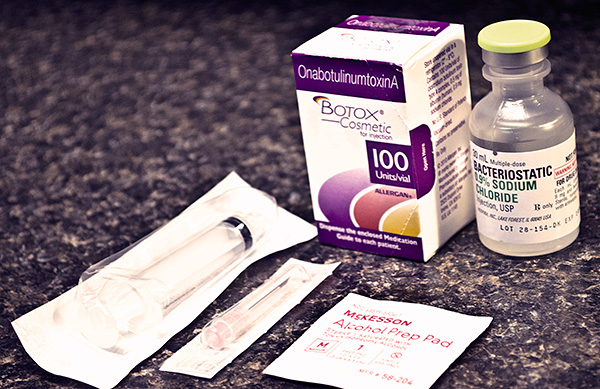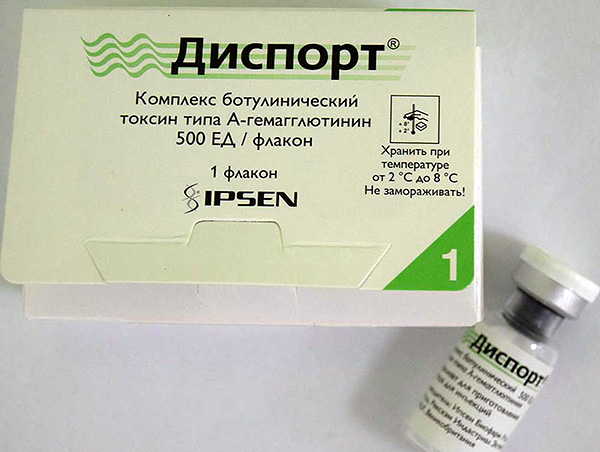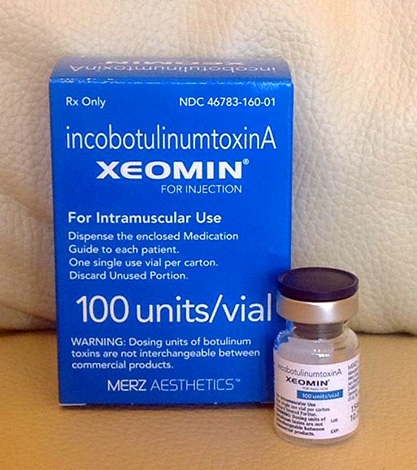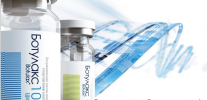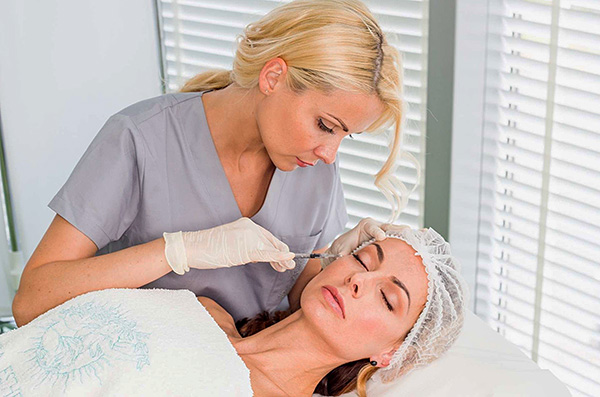
Botulinum therapy is the treatment of aesthetic or clinical disorders of the muscles and skin of the face, carried out by intramuscular injection of botulinum toxin preparations (less often subcutaneously). Initially used for the treatment of various clinical pathologies (strabismus, cervical dystonia, post-stroke spasticity, chronic migraine), botulinum therapy over time has been widely recognized in cosmetology, as it allowed to eliminate facial wrinkles with high efficiency.
Actually, it is the fight against wrinkles today that is the main point of application of most botulinum therapy methods in cosmetology. In therapeutic practice, botulinum toxin is generally used to treat certain nervous and muscle pathologies (for example, hyperhidrosis, strabismus, etc.).
On a note
In addition to the fight against wrinkles, botulinum therapy methods are used to correct various aesthetic problems associated with muscle asymmetry, their excessive tension, and their individual structural features. Moreover, such a correction is possible not only for the face, but also for any other parts of the body. So, the practice of changing the relief of the deltoid, calf, and sciatic muscles is widespread, although botulinum toxin is used less often for these purposes, and the treatment approaches themselves have certain specifics.
Despite the long history of application, the abundance of successful examples and positive reviews, the general attitude to botulinum therapy in the countries of the former Soviet Union can be called cautious. This is primarily due to the fact that the active ingredients used are preparations based on botulinum toxin, widely known as the strongest poison of natural origin. Many people are scared by the prospect of intentionally introducing such a dangerous substance into the body.
There are also precedents for either the independent use of the drug by people without appropriate training, or recourse to unskilled specialists.
In many such cases, the result of the use of botulinum toxin was very different from the intended one, which led to the accumulation of a certain negative in relation to both the drug and the method itself.
Nevertheless, the popularity of botulinum toxin therapy continues to grow - an increasing number of potential patients learn about its capabilities, but can still doubt the safety and effectiveness of this procedure. We will talk more about its principles and rules of application in more detail ...
The principle of action of botulinum toxin with topical administration
The main principle of botulinum therapy is local intramuscular administration of special preparations of botulinum toxin, which leads to relaxation of the corresponding muscles (face or other parts of the body).
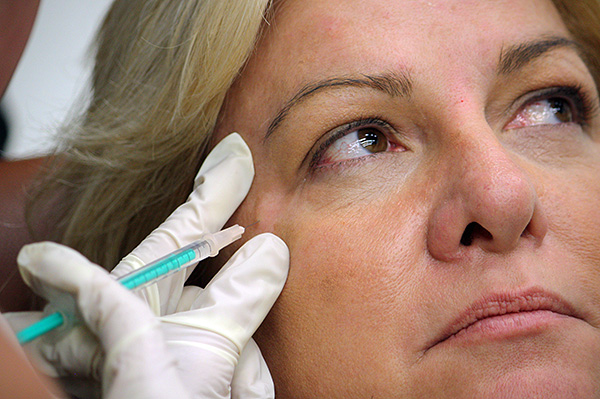
With botulinum toxin injections, local muscle relaxation occurs, as a result of which wrinkles in this particular area are smoothed out ...
With this introduction, botulinum toxin itself does not enter any significant amounts into the blood and does not have a toxic effect on the body. However, locally in the muscle fibers into which it is introduced, the toxin acts in the same way as it would affect the body as a whole: it disrupts the transmission of nerve impulses from neurons to muscles.
As a result, both conscious and unconditioned nerve impulses do not affect muscle activity, the muscle itself relaxes and does not tighten the skin in those areas under which it is located.
Outwardly, this manifests itself in the fact that wrinkles disappear at the injection sites of botulinum toxin due to spastic or conscious contractions of the facial muscles.
In case of errors in the administration of botulinum toxin, or for some reasons beyond the control of the doctor, the action of the drug sometimes turns out to be excessive, which leads to undesirable side effects and complications after botulinum therapy. In the vast majority of cases, with qualified procedures, such side effects are very short-term and quickly end on their own.
On a note
When botulinum toxin enters the body during food poisoning, the same nerve effect of the poison manifests itself in relation to the vital muscles - the heart, diaphragm, large skeletal muscles. The victim's heart stops, respiratory paralysis and death occurs.
With the correct injection of botulinum toxin medications by a cosmetologist, the risk of such intoxication is practically absent - the substance is not able to spread throughout the body and act on vital organs.
The botulinum toxin preparation itself is not poison, since the toxin in it is bound by several auxiliary proteins. This is required to maintain its stable structure in the composition of the solution.
When it enters the body under the action of enzymes in the intercellular space, the protein complex breaks down and pure botulinum toxin is released, which has a further physiological effect.
Cosmetic result from the procedures
The main effect for which botulinum toxin therapy is most often performed is the disappearance of facial wrinkles. And today the methods of botulinum therapy have been worked out so much that they can get rid of wrinkles in almost all areas of the face and at almost any depth and age.
Most often, botulinum therapy is carried out to eliminate wrinkles in the following places:
- On the nose and forehead;
- Between the nose and lips (the so-called "nasolabs" - nasolabial folds);
- From the outer sides of the eyes (the so-called "crow's feet");
- On the chin;
- To the side of the lips.
As an example, the photo below shows the appearance of the lower third of the face in women before and after botulinum therapy:
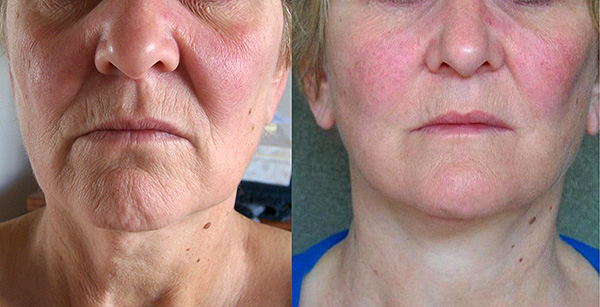
An example of effective wrinkle correction with botulinum toxin injections.

With the correct implementation of the procedure, it is possible to achieve a significant cosmetic effect.
Often, with the help of botulinum toxin injections, wrinkles and wrinkles on the neck and décolleté are also eliminated.
Nevertheless, today among cosmetologists, the most accepted tactic for choosing places for the introduction of botulinum toxin is the principle of the “whole face”. The fact is that attempts to eliminate wrinkles in certain areas can lead to the fact that these areas will be distinguished after botulinum therapy against other untreated areas, which will not only not improve the patient's appearance, but even spoil him, make him unnatural. Proper administration of the drug, taking into account the structure and defects of the skin of the whole face, allows you to preserve its specificity and not to highlight individual areas.
Feedback
“Botox started stabbing about two years ago. Very good procedure. I had no particular problems, the age was not the same, either 31, or 32 then. Pricked so that problems do not appear. But she immediately noticed that the wrinkles around her lips smoothed after the first procedure. Initially pricked for correction from the bottom of the face, but the last time I also did it near the eyes. I heard a lot about the harm of such botulinum toxin therapy, but everything was fine with me. Here a lot depends on the technician and the cosmetologist. In St. Petersburg, I was injected with a very professional doctor, two hours after the procedure, even points from the injections did not remain. A couple of times I stabbed in Moscow when I lived there, so I didn’t like it there, for a long time there were traces from the procedure, although the cost was higher. Now stabbing constantly. All good".
Olga, St. Petersburg
Also, botulinum therapy, especially with prolonged use, contributes to some softening of facial features, restoration of natural roundness, elimination of the effect of “tightened” skin, especially among athletes.
You can also affect the severity of scars and scars on the skin. The healing of such injuries usually proceeds with the tension of the muscles surrounding the wound itself. The timely introduction of botulinum toxin into these muscles helps smooth the edges of the wound and form a smoother, sometimes almost invisible scar.
Below in the photo you can see the result of the treatment of a scar in a man using botulinum toxin.
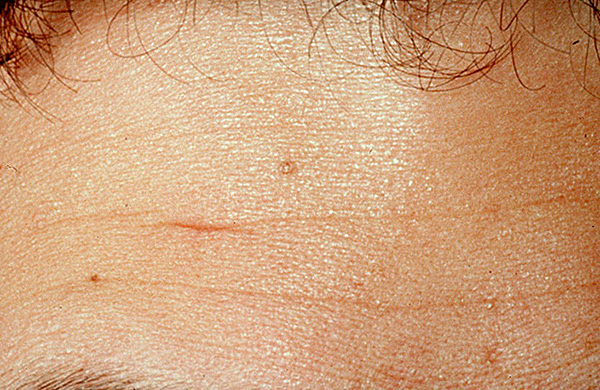
Condition before treatment - a reddish scar is clearly visible on the forehead, which the patient would like to get rid of.

The use of botulinum toxin injections at an intermediate stage of treatment allows achieving the most favorable conditions for wound healing.
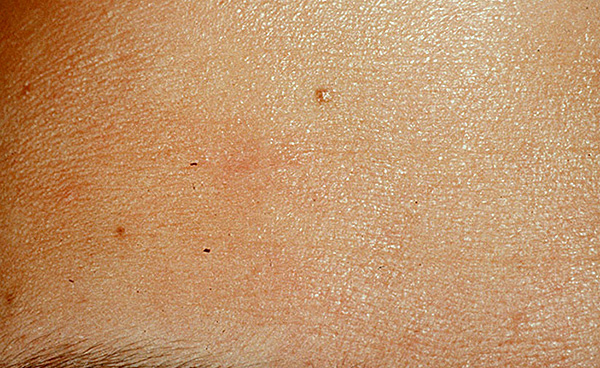
And so the result looks ...
With botulinum therapy, individual sections of large muscles can affect their relief and structure. This is used, for example, to obtain the effect of more elongated and slender calf muscles, especially in women with an endomorphic physique, in which even slightly trained muscles look “brutal”.
The same methods can be used to correct the appearance of the deltoid muscles, muscles of the forearm, and chest.
Finally, a separate effect of botulinum therapy is the deactivation of sweat glands on the skin of the treated areas. This effect is used in the treatment of hyperhidrosis (excessive perspiration) in the armpits, groin and other parts of the body.
Types of therapy
There are two ways to administer botulinum toxin, which define two different types of botulinum toxin therapy:
- Classical intramuscular administration of the drug;
- Mesobotox.
They differ in that with classical therapy the drug is injected directly into the muscles to be deactivated, and with mesobotox it is injected under the skin so that it does not get into the muscle itself.
In the classical procedure, the effect is more pronounced, it allows you to eliminate even deep wrinkles. But with it, the likelihood of side effects is higher and a larger number of contraindications are associated with it.
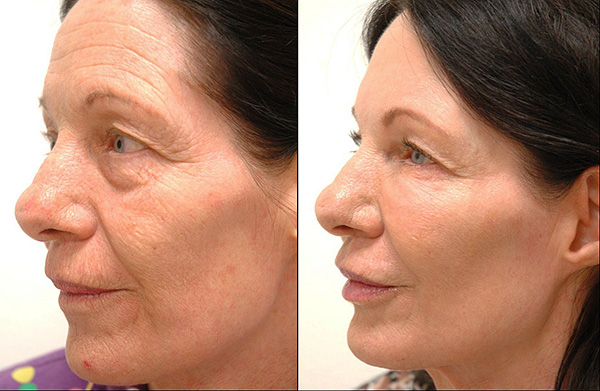
Botulinum therapy can even correct very deep facial wrinkles, creating a well-defined “anti-aging” effect.
Mesobotox provides a less pronounced result, it is achieved by eliminating mainly small purse-string wrinkles, including in women with very sensitive skin. It is not possible to act on more pronounced and chronic wrinkles with the help of this technique. At the same time, mesobotox is safer, has a small number of contraindications and rarely causes side effects.
The procedure for botulinum therapy
In general, botulinum therapy is a relatively safe procedure, and therefore, on the part of the patient, preparing for it and conducting it is not particularly difficult.
On a note
In the West, where botulinum toxin injections have already become very common, botulinum therapy is called "lunch injections" - many women and men do them all the time and go to this procedure, like a manicure or a haircut.
Preparation for botulinum therapy consists of a thorough examination by a doctor and analysis of the condition of his skin, face and neck muscles, and diagnosis of problems. At this stage, the doctor not only assesses the patient’s condition and receives information about the purpose of the procedure from him, but also studies his anamnesis, finds out the causes of specific skin defects and facial expressions, learns about the recent use of drugs that can affect the result of treatment. Here, it is important for a specialist to study muscle activity during certain patient movements, individual anatomy features. All this will be needed in the future to determine the tactics of the introduction of botulinum toxin.
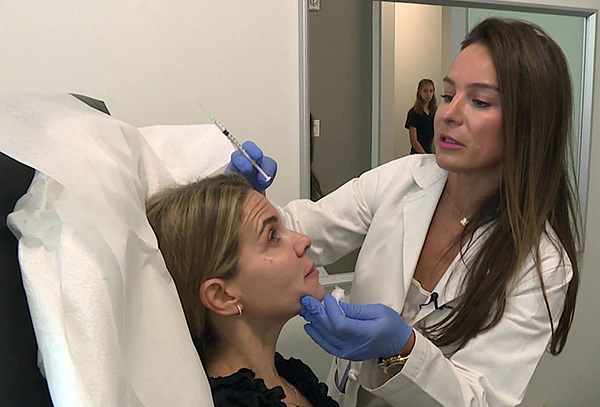
In most cases, the patient does not need to somehow specifically prepare for the procedure, and botulinum toxin injections can be made on the very first visit to the cosmetologist.
The results of this initial inspection are:
- Coordination of the goals of botulinum therapy with a list of all areas of the face or body on which you want to get one or another result;
- Coordination of terms and prices of treatment, number of procedures and repeated courses;
- Formation by the doctor of an arrangement of points for injection;
- Selection of the drug based on the goals, financial capabilities of the patient and the availability of certain funds.
Special events to prepare for botulinum therapy itself are not necessary. Before the procedure, you should thoroughly wash your face, rinsing all the cosmetics from it. All further manipulations will be carried out by the doctor.
A voluntary informed consent to botulinum therapy is signed directly in the office, after which the doctor proceeds with the procedure. Its order is this:
- The doctor restores (dilutes) the powder of the drug to obtain the amount of liquid needed for injection. As a rule, for this, the powder is diluted with saline without additional components. In some cases, the drug is diluted with saline with the addition of benzyl alcohol, which reduces pain during injections;
- The skin at the injection sites is treated with an anesthetic;
- Then the doctor conducts injections at selected points, introducing into each of them a strictly verified amount of funds. Here, the accuracy of the drug in specific areas of muscle fibers or under the skin depends on the professionalism of the doctor.
In one procedure, the doctor makes from 5 to 30 injections, depending on the purpose and area of administration. The remains of the preparation prepared for the procedure are poured, because they are no longer suitable for reuse.
The effect of injections does not appear immediately, but only about 5-10 days after the procedure. During this time, botulinum toxin penetrates the axons of nerve cells and binds synaptic vacuoles with acetylcholine, as a result of which the muscles relax, the skin is smoothed. The effect lasts from 2 to 8 months, after which the procedure must be repeated.
After botulinum toxin injections, the patient should not:
- Lie down for 4 hours;
- Rub and crush fingers on the face throughout the day to prevent the spread of botulinum toxin to areas that are not subject to treatment;
- Expose the body to great physical exertion;
- Wash your face with hot water;
- Take alcohol or blood circulation-enhancing pharmaceuticals.
The doctor usually gives the patient individual instructions for rehabilitation after botulinum therapy.
In many cases, patients prefer to spend several hours in the clinic after treatment. During this time, the severity of points from injections decreases and the likelihood of developing severe allergic reactions is excluded.
On the safety of the procedure and contraindications to it
Today botulinum therapy is considered a completely safe procedure. The risk of poisoning by botulinum toxin itself during its conduct is practically eliminated, other life-threatening conditions are also very rare.

The introduction of botulinum toxin for cosmetic purposes is a completely safe procedure, very rarely leading to any serious complications.
Contraindications to botulinum therapy are:
- Pregnancy and lactation - it is not completely known how the procedures can affect the fetus and the baby, therefore, at least up to a year with HB they are not carried out;
- The patient has an acute urinary tract infection;
- Children's age up to 2 years (according to other sources - 6 years);
- The presence of an infectious skin lesion at the sites of the alleged administration of the drug;
- An allergy to any botulinum toxin drug.
Even in the absence of these contraindications, side effects may occur, which, however, for the most part pass quickly.
On a note
In the entire history of botulinum therapy, 28 deaths associated with it are known. Most of them arose due to allergic reactions to drugs, or because of serious violations in the conduct of procedures by doctors.
Possible side effects of botulinum toxin
The most common are various cosmetic side effects after botulinum therapy.
Such unwanted effects can be associated with several reasons:
- The introduction of the drug into the wrong muscle (erroneous or caused by the specifics of the patient's anatomy);
- The introduction of too large doses of the drug, which leads to effects on the muscles that should not be involved in the process;
- Errors in choosing the depth of injection;
- Errors at the stage of evaluating facial expressions and drawing up a pattern of injections;
- Violation of the patient's rehabilitation conditions.
Typical cosmetic consequences of the procedure are ptosis (drooping eyelids), dysphagia (inability to swallow), swelling at the injection site, violation of the symmetry of facial movements (“crooked” smile), “Mephistopheles eyebrows”, eversion of the eyelids and others.
The photo below shows an example of one of the possible consequences of botulinum therapy - drooping eyelids:
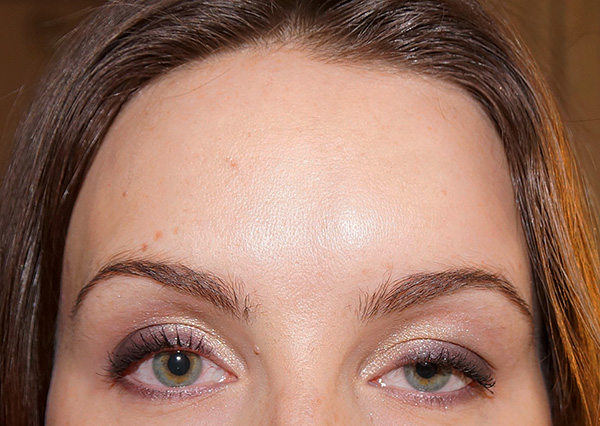
The prolapse of the century after Botox injections
All these effects disappear within 1-2 months after the procedures.
The following clinical consequences of botulinum toxin injections are also possible:
- Keratitis;
- Dry eyes, conjunctivitis;
- Respiratory symptoms (runny nose, cough);
- Allergy, up to severe anaphylactic conditions;
- Exacerbation of herpes infection.
These complications are very rare, and if they occur, they disappear within a few days (with the exception of conjunctivitis, which is caused by temporary inactivation of the muscle responsible for blinking).
If ulcers appear at the injection site, an urgent consultation with a doctor is necessary and sometimes specific therapy.
Feedback:
“I did Botox the first time two days ago. The location of the points is no longer visible, but pricked in the forehead, around the eyes and in the eyebrows. A variation of Botox is Allergan. I was very afraid of adverse events, I chose a doctor for a long time. As a result, it turned out this way: the outer vertical wrinkles themselves near the eyes have already passed, but new, generally incomprehensible ones appeared - horizontal at the top of the cheeks. It’s as if the skin is plastic. The doctor said that within 2 weeks should pass, but now it’s inconvenient for me to go out to people ... "
Tatyana, from forum posts
Botulinum toxin preparations most widely used in cosmetology practice
For botulinum therapy today, several botulinum toxin preparations are used that are similar in their properties and differ in some specific details that practically do not affect the result of the procedures.
The most popular of these drugs are the following:
- Botox (Botox) - its name has become a household name for botulinum therapy itself and for botulinum toxin preparations in general. It is made in the USA, is issued in bottles with the content of active substance of 50-100 units. Also known as Allergan - by the name of the company that produces it;

This is what the original Botox drug (manufactured by Allergan) looks like.
- Dysport manufactured by Ipsen Biopharm, UK. It is sold in bottles containing 300 and 500 units of botulinum toxin;

One of the most popular Botox analogues is Dysport.
- Xeomin, German-made, containing 100 units of active substance in a vial.

The drug Xeomin
Also on sale is the Japanese drug Mioblock and Russian Relatox, and Korean Neuronox and Chinese Prosigne are under development. In their action, all these drugs are analogues of each other, although they differ in composition.
The products on the market have passed the necessary clinical trials and are approved for use in aesthetic cosmetology and clinical neuropathology. All of them are approximately equally safe and in many cases interchangeable. However, the replacement of one drug by another is carried out only by a doctor, taking into account the amount of active substance in the agent and the particular treatment of a particular patient.
Alternative methods of wrinkle correction in cosmetology: advantages and disadvantages of botulinum therapy before them
There is no full-fledged substitute alternative to botulinum therapy today. Other cosmetic methods allow you to get similar effects, but they are used in other cases.
For example, as an alternative to botulinum toxin injections, the following are mistakenly considered:
- Hyaluronic acid injections - to some extent, provide the removal of wrinkles caused by sagging and reduced skin elasticity. The dynamic wrinkles caused by constant muscle tension, hyaluronic acid is practically not affected. It is also used to combat dryness, sagging skin, age spots, for biorevitalization of the skin and facial contouring - that is, in cases when botulinum therapy is not carried out at all;
- Injections of other fillers - by tasks and effectiveness, they are similar to injections of hyaluronic acid, and therefore it is impossible to consider them as an alternative to botulinum therapy;
- Fractional photothermolysis - just like filler injections, is designed to eliminate wrinkles and other cosmetic skin defects that occur due to malnutrition or age-related changes. This procedure has practically no effect on the wrinkles of dynamic etiology.
Consequently, botulinum therapy and other methods of wrinkle removal in cosmetology occupy completely different niches. Botulinum toxin injections are used to combat wrinkles caused by constant muscle tension. And filler injections and photothermolysis are used to treat skin defects associated with age-related changes and malnutrition. These procedures can complement each other, but are not interchangeable.
As a result, botulinum therapy can be described as an effective and fairly safe cosmetic procedure that is gaining popularity in modern cosmetology and allows you to effectively fight wrinkles and some other aesthetic defects of the skin and muscles. Despite some restrictions, it is allowed for most patients, and if properly implemented, it really gives the desired result.
Interesting video: myths and the reality of botulinum therapy
An example of Botox injections into the forehead and between the eyebrows with detailed explanations of the cosmetologist

